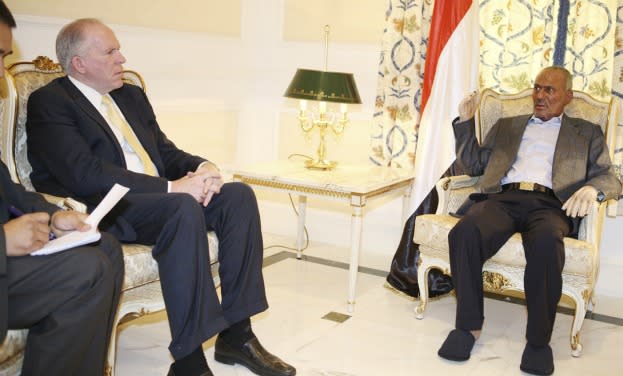Ali Abdullah Saleh Is Looking More Like Himself

Only days after appearing on television for the first time since an assassination attempt in early June, Yemeni President Ali Abdullah Saleh has made another public appearance. On Sunday he met with U.S. counterterrorism chief John Brennan on Sunday in Riyadh, where Saleh is recovering from surgery and severe burns he sustained in the attack on his palace. According to The New York Times, Brennan urged Saleh to sign a Gulf Cooperation Council deal that would have the president step down in exchange for immunity from prosecution, threatening to withhold further U.S. aid to Yemen if Saleh refuses to do so.
RELATED: How a Deal to Remove Yemen's President Could Still Unravel
In the photos from the meeting, Saleh looks similar to how he looked last Thursday, with his face singed and his hands bandaged. But this time he's not wearing a head covering or sporting an uncharacteristic beard (he appears to be transitioning from white stubble to his trademark thick mustache). He also looks more relaxed, crossing his legs and taking off his shoes.
RELATED: Yemen's Uprising Appears to Be Stagnating
RELATED: A Brief History of Hugo Chavez's Mysterious Health Issues
RELATED: Deadly Violence Erupts Across Yemen
Euro News has video of the meeting:
RELATED: A New Round of Reports on Yemeni President's Imminent Departure
Saleh's appearance and the meeting with Brennan raise larger questions about whether the president will return to Yemen or finally bow to six months of anti-government protests and step down. The current political impasse has sparked humanitarian and economic crises, enabled militants to consolidate power in the south, and deflated the protest movement. At Foreign Policy today, Jeb Boone writes that power in Yemen is perilously fragmented, with Saleh's deputy nominally in control in the capital, Sanaa, Saleh's relatives really in control Sanaa, Yemen's political opposition holding sway in Sanaa's Change Square, tribes enjoying autonomy in the north and west, protesters battling with government forces in the southern city of Taiz, and separatist and militant movements growing in the south.